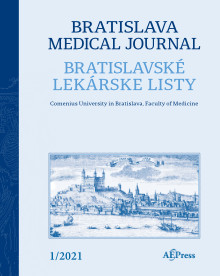Journal info
|
||||
Select Journal
Journals
Bratislava Medical Journal 2024 2023 2022 2021 2020 2019 2018 2017 2016 2015 2014 2013 2012 Ekologia - Ecology Endocrine Regulations General Physiology and Biophysics Neoplasma Acta Virologica Studia Psychologica Cardiology Letters Psychológia a patopsych. dieťaťa Kovove Materialy-Metallic Materials Slovenská hudba 2025Webshop Cart
Your Cart is currently empty.
Info: Your browser does not accept cookies. To put products into your cart and purchase them you need to enable cookies.
Bratislava Medical Journal Vol.117, No.9, p.525-529, 2016 |
||
| Title: Can platelet-rich plasma be used safely in intra-abdominal operations? | ||
| Author: F. Kaya, K. Kismet, H. Ozer, V. G. Soylu, M. E. Duymus, Y. A. Akgun, A. Demir, P. Celepli, T. Guclu, S. Bolat, E. Ertas | ||
| Abstract: OBJECTIVES: In this study, it was aimed to investigate whether or not platelet‑rich plasma (PRP) causes intra-abdominal adhesions and therefore, whether or not PRP can be used safely in intra-abdominal operations. METHODS: Of the total of 35 animals, 5 were used as donors for the preparation of platelet‑rich plasma (PRP). The surgical procedures were performed on the remaining 30 animals. These rats were randomized and divided into 3 groups of 10. In Group 1, no adhesion induction was performed. Adhesion was induced by cecal abrasion and peritoneal resection model in Groups II and IIII. In Group 2, no treatment was given. In Group 3, 1 cc PRP was applied on the cecum. The rats were sacrificed on postoperative day 21. RESULTS: According to adhesion scores, the difference between the sham and PRP groups was not statistically significant. There was also no significant difference between the control and PRP groups, but the adhesion scores in the PRP group was lower than those in the control group. On histopathological evaluation, the difference between the sham and PRP groups was not statistically significant. There was also no significant difference between the control and PRP groups, but the average fibrosis and inflammation scores in the PRP group were lower than those in the control group. CONCLUSION: The results of the present study have demonstrated that PRP neither reduced nor exacerbated postoperative adhesions. Thus, PRP can be used safely in experimental and clinical studies where it will be applied intra-abdominally (Tab. 2, Fig. 3, Ref. 11). |
||
| Keywords: platelet rich plasma, intra-abdominal operations, adhesions, rats | ||
| Published online: 21-Sep-2016 | ||
| Year: 2016, Volume: 117, Issue: 9 | Page From: 525, Page To: 529 | |
| doi:10.4149/BLL_2016_102 |
||
|
|
 download file download file |
|

